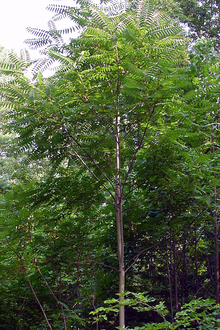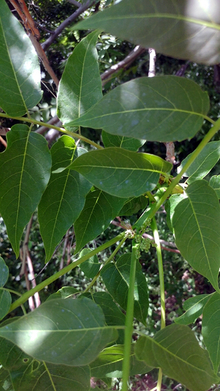Quick facts
Tree of heaven is a Restricted noxious weed and is considered an early detection species not present or with a limited distribution in Minnesota.
- Tree-of-heaven grows well in a variety of soil types and tolerates varying soil moisture conditions, allowing it to grow quickly and colonize disturbed areas.
- It grows well in urban areas and is a host for the invasive spotted lanternfly.
- Roots are allelopathic, producing chemicals that prevent the germination of nearby plants.
Tree-of-heaven should be reported. The Minnesota Department of Natural Resources provides detailed recommendations for reporting invasive species.
How to identify tree-of-heaven
- Deciduous tree, 60–80' in height.
- Species has both female and male plants.
Stem
- Smooth stem with pale gray bark.
Branches
- Brittle
Leaves
- Compound, alternate leaves with smooth margins; can reach 1‒4' long.
- Each leaf has 11–41 leaflets with up to five distinct glands near the leaflet base.
- Leaves have a strong odor.
Flowers
- Small, light yellow to green in color, and form in large showy clusters.
- They have a strong, unpleasant odor.
Fruit and seeds
- Clusters of twisted samaras develop mid-summer.
- A pinkish hue develops, then matures to light tan.
- Samaras are dispersed by wind up to 300 feet.
- Trees in the 12- to 20-year age class produce lots of seed.
- Individual female plants can produce 325,000 seeds a year.
Roots
- Shallow and grow rapidly.
- Stem shoots may sprout from roots near the soil surface.
- Root sprouts can emerge 50–90' away from established trees.
Reviewed in 2023




